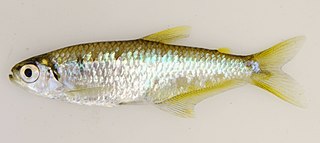
Characiformes is an order of ray-finned fish, comprising the characins and their allies. Grouped in 18 recognized families, more than 2000 different species are described, including the well-known piranha and tetras.

Characidae, the characids or characins is a family of freshwater subtropical and tropical fish, belonging to the order Characiformes. The name "characins" is the historical one, but scientists today tend to prefer "characids" to reflect their status as a by and large monophyletic group at family rank. To arrive there, this family has undergone much systematic and taxonomic change. Among those fishes that remain in the Characidae for the time being are the tetras, comprising the very similar genera Hemigrammus and Hyphessobrycon, as well as a few related forms such as the cave and neon tetras. Fish of this family are important as food and also include popular aquarium fish species.
In biological classification, a subfamily is an auxiliary (intermediate) taxonomic rank, next below family but more inclusive than genus. Standard nomenclature rules end botanical subfamily names with "-oideae", and zoological subfamily names with "-inae".

Hyphessobrycon is a genus of freshwater fish in the family Characidae. These species are among the fishes known as tetras. The genus is distributed in the Neotropical realm from southern Mexico to Río de la Plata in Argentina. Many of these species are native to South America; about six species are from Central America and a single species, H. compressus is from southern Mexico.

Astyanax is a genus of freshwater fish in the family Characidae of the order Characiformes. Some of these fish, like many of their relatives, are kept as aquarium pets and known collectively as tetras. With around 150 described species and new ones being described yearly, this genus is among the largest of the entire order; Hyphessobrycon also has more than 145 species and which one is larger at any one time depends on whether more species have been recently described in one or the other. The blind and colorless cave tetra of Mexico is a famous member of the genus, but its taxonomic position is disputed: Some recognize it as part of the Mexican tetra and this is supported by phylogenetic evidence, but others recognize the cave form as a separate species, A. jordani.

Bryconops is a genus of freshwater fish in the family Iguanodectidae from South America. It consists of small fish, all under half-a-foot long, with slender bodies and silvery scales, though there is some mild color variation. Several species can be identified by way of a humeral patch, and others have a reddish ocellus, or eyespot, on one or both lobes of the dorsal fin.
Corynopoma riisei, also known as the sword-tail characin, is a species of characin found in Colombia, Trinidad and Tobago and Venezuela. It is also kept as an aquarium fish. This species is the only member of the genus Corynopoma.

Diapoma is a genus of characins from tropical South America.

Hemibrycon is a genus of characins. They are mainly found in South America, Trinidad in the Caribbean), and H. dariensis of east Panama.
Hypobrycon is a genus of characin found in the Uruguay River basin in South America.
Hysteronotus megalostomus is a species of characin endemic to Brazil where it is found in the upper São Francisco River basin. This species is the only member of the genus Hysteronotus.
Odontostilbe is a genus of characins from tropical Central and South America, with 17 currently recognized species:
Rhinopetitia is a genus of characins endemic to Brazil.
Trochilocharax ornatus is a species of characin endemic to Peru. This species is the only member of the genus Trochilocharax.
Curimatopsis is a genus of small South American fish in the family Curimatidae. They are native to freshwater habitats in the Amazon, Orinoco and Paraguay basins, as well as river of the Guianas.
Stanley Howard Weitzman was a Research Scientist Emeritus at Division of Fishes, National Museum of Natural History, Washington, D.C.
Bryconops inpai is a small freshwater fish native to the rivers of South America. It only lives in two particular river systems - the Casiquiare and Negro - which means that its range is restricted to the northern half of the continent. It has indistinct humeral spots, and is bluish-silver in life, which is unusual for members of Bryconops; they are more often plain silver or greenish-silver.
Bryconops munduruku is a small freshwater fish of the family Iguanodectidae that lives in the rivers of South America. Its adipose fin is black, with a clear base, and it has two humeral spots, which is a feature it shares with few congeners. Its fins are a variety of yellow, red, black, and clear, and mature males have hooks on select fin-rays.
Bryconops vibex is a small freshwater fish from the rivers of Venezuela, known solely from the Rio Cataniapo. The body is slender, though with an element of sturdiness, and it has one humeral spot by each pectoral fin. It bears visual similarities to several congeners, but can be differentiated by way of many factors.
Bryconops sapezal is a small freshwater fish native to the Rio Tapajós basin of Brazil. It is one of the more recent additions to its genus, described in 2018, and has a name that means "covered in sapê", or thatching. This originates from the Sapezal municipality of Mato Grosso, Brazil, which is type locality of B. sapezal.






